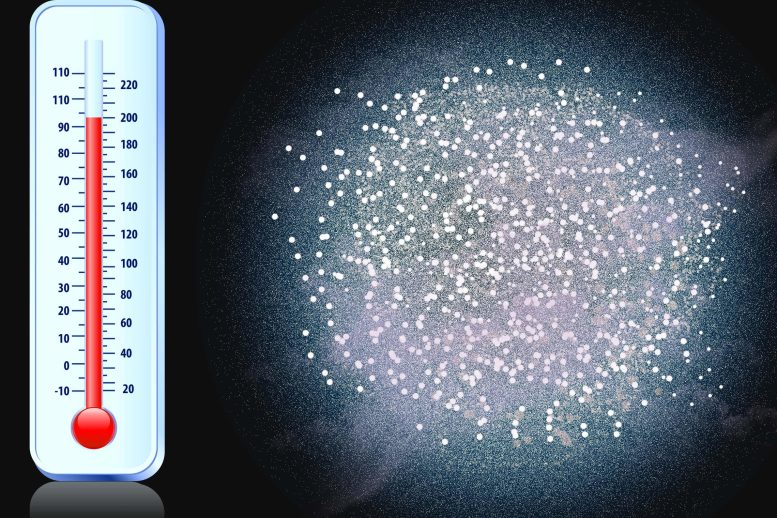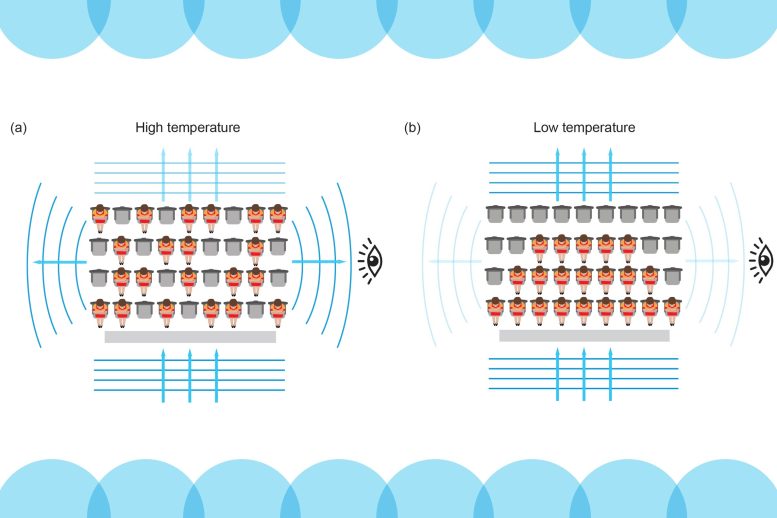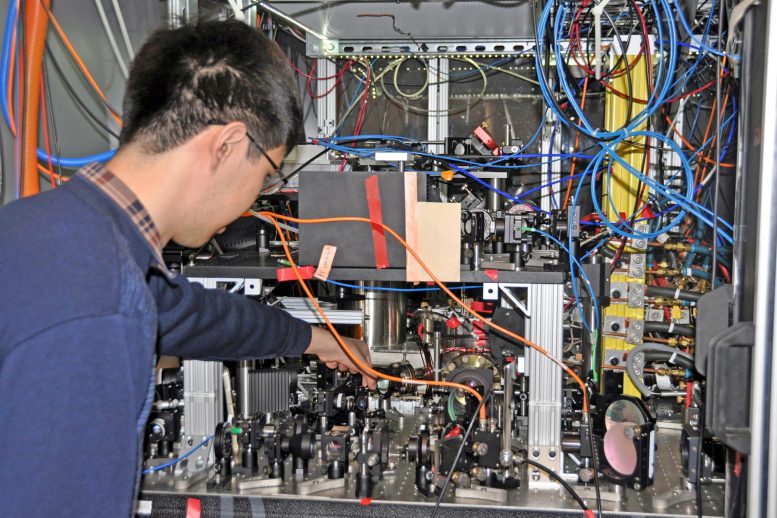
How Ultracold, Superdense Atoms Become Invisible
A new study confirms that as atoms are chilled and squeezed to extremes, their ability to scatter light is suppressed.
An atom’s electrons are arranged in energy shells. Like concertgoers in an arena, each electron occupies a single chair and cannot drop to a lower tier if all its chairs are occupied. This fundamental property of atomic physics is known as the Pauli exclusion principle, and it explains the shell structure of atoms, the diversity of the periodic table of elements, and the stability of the material universe.
Now, MIT physicists have observed the Pauli exclusion principle, or Pauli blocking, in a completely new way: They’ve found that the effect can suppress how a cloud of atoms scatters light.
Normally, when photons of light penetrate a cloud of atoms, the photons and atoms can ping off each other like billiard balls, scattering light in every direction to radiate light, and thus make the cloud visible. However, the MIT team observed that when atoms are supercooled and ultrasqueezed, the Pauli effect kicks in and the particles effectively have less room to scatter light. The photons instead stream through, without being scattered.

In their experiments, the physicists observed this effect in a cloud of lithium atoms. As they were made colder and more dense, the atoms scattered less light and became progressively dimmer. The researchers suspect that if they could push the conditions further, to temperatures of absolute zero, the cloud would become entirely invisible.
The team’s results, reported today in Science, represent the first observation of Pauli blocking’s effect on light-scattering by atoms. This effect was predicted 30 years ago but not observed until now.
“Pauli blocking in general has been proven, and is absolutely essential for the stability of the world around us,” says Wolfgang Ketterle, the John D. Arthur Professor of Physics at MIT. “What we’ve observed is one very special and simple form of Pauli blocking, which is that it prevents an atom from what all atoms would naturally do: scatter light. This is the first clear observation that this effect exists, and it shows a new phenomenon in physics.”
Ketterle’s co-authors are lead author and former MIT postdoc Yair Margalit, graduate student Yu-kun Lu, and Furkan Top PhD ’20. The team is affiliated with the MIT Physics Department, the MIT-Harvard Center for Ultracold Atoms, and MIT’s Research Laboratory of Electronics (RLE).
A light kick
When Ketterle came to MIT as a postdoc 30 years ago, his mentor, David Pritchard, the Cecil, and Ida Green Professor of Physics, made a prediction that Pauli blocking would suppress the way certain atoms known as fermions scatter light.
His idea, broadly speaking, was that if atoms were frozen to a near standstill and squeezed into a tight enough space, the atoms would behave like electrons in packed energy shells, with no room to shift their velocity, or position. If photons of light were to stream in, they wouldn’t be able to scatter.

“An atom can only scatter a photon if it can absorb the force of its kick, by moving to another chair,” explains Ketterle, invoking the arena seating analogy. “If all other chairs are occupied, it no longer has the ability to absorb the kick and scatter the photon. So, the atoms become transparent.”
“This phenomenon had never been observed before, because people were not able to generate clouds that were cold and dense enough,” Ketterle adds.
“Controlling the atomic world”
In recent years, physicists including those in Ketterle’s group have developed magnetic and laser-based techniques to bring atoms down to ultracold temperatures. The limiting factor, he says, was density.
“If the density is not high enough, an atom can still scatter light by jumping over a few chairs until it finds some room,” Ketterle says. “That was the bottleneck.”
In their new study, he and his colleagues used techniques they developed previously to first freeze a cloud of fermions — in this case, a special isotope of lithium atom, which has three electrons, three protons, and three neutrons. They froze a cloud of lithium atoms down to 20 microkelvins, which is about 1/100,000 the temperature of interstellar space.
“We then used a tightly focused laser to squeeze the ultracold atoms to record densities, which reached about a quadrillion atoms per cubic centimeter,” Lu explains.
The researchers then shone another laser beam into the cloud, which they carefully calibrated so that its photons would not heat up the ultracold atoms or alter their density as the light passed through. Finally, they used a lens and camera to capture and count the photons that managed to scatter away.
“We’re actually counting a few hundred photons, which is really amazing,” Margalit says. “A photon is such a little amount of light, but our equipment is so sensitive that we can see them as a small blob of light on the camera.”
At progressively colder temperatures and higher densities, the atoms scattered less and less light, just as Pritchard’s theory predicted. At their coldest, at around 20 microkelvin, the atoms were 38 percent dimmer, meaning they scattered 38 percent less light than less cold, less dense atoms.
“This regime of ultracold and very dense clouds has other effects that could possibly deceive us,” Margalit says. “So, we spent a few good months sifting through and putting aside these effects, to get the clearest measurement.”
Now that the team has observed Pauli blocking can indeed affect an atom’s ability to scatter light, Ketterle says this fundamental knowledge may be used to develop materials with suppressed light scattering, for instance to preserve data in quantum computers.
“Whenever we control the quantum world, like in quantum computers, light scattering is a problem, and means that information is leaking out of your quantum computer,” he muses. “This is one way to suppress light scattering, and we are contributing to the general theme of controlling the atomic world.”
Reference: “Pauli blocking of light scattering in degenerate fermions” by Yair Margalit, Yu-Kun Lu, Furkan Çagri Top and Wolfgang Ketterle, 18 November 2021, Science.
DOI: 10.1126/science.abi6153
This research was funded, in part, by the National Science Foundation and the Department of Defense. Related work by teams from the University of Colorado and the University of Otago appears in the same issue of Science.
Never miss a breakthrough: Join the SciTechDaily newsletter.
13 Comments
This is not an issue of being dense enough. It’s simply a question of whether these atoms are cold enough to behave as waves vice particles. Frankly there is too much matter between us and the center of our galaxy for us to see it, if that matter exists and behaves as particles. However if that matter exists in wave form, that light can reach us. It can reach us, but it will suffer a red shift in the process. Light from farther away will suffer a larger red shift. The universe may be expanding, but it is not accelerating. Can we please operate within the confines of the laws of thermodynamics?
First, regarding the experiment it is an observation that the earlier densities weren’t enough and when increased densities were enough.
Second, you are confusing quantum field theory which describes fields where particles are ripples that can be both localized (particles) and spread out (wavepackets) with its application to matter particles. But that has nothing to do with observing such matter as dust towards the galactic center, which is what we see.
Third, cosmological redshift is caused by space (and so traveling photon wavepacket) expansion, not the tired light of old which was known to be inconsistent with observation already in the 30s.
“The concept was first proposed in 1929 by Fritz Zwicky, who suggested that if photons lost energy over time through collisions with other particles in a regular way, the more distant objects would appear redder than more nearby ones. Zwicky himself acknowledged that any sort of scattering of light would blur the images of distant objects more than what is seen. Additionally, the surface brightness of galaxies evolving with time, time dilation of cosmological sources, and a thermal spectrum of the cosmic microwave background have been observed—these effects should not be present if the cosmological redshift was due to any tired light scattering mechanism.[1][2][3] Despite periodic re-examination of the concept, tired light has not been supported by observational tests and remains a fringe topic in astrophysics.[4]” [“Tired light”, Wikipedia].
Fourth, by cosmological redshift observation we know that space expansion is accelerating, and we know its cause (vacuum energy aka dark energy). That does not break thermodynamics but is consistent with thermodynamics of general relativity, a complex topic – the expansion is thermodynamically a negative pressure term in Einstein’s equations .
“Independently of its actual nature, dark energy would need to have a strong negative pressure to explain the observed acceleration of the expansion of the universe. According to general relativity, the pressure within a substance contributes to its gravitational attraction for other objects just as its mass density does. This happens because the physical quantity that causes matter to generate gravitational effects is the stress–energy tensor, which contains both the energy (or matter) density of a substance and its pressure. In the Friedmann–Lemaître–Robertson–Walker metric, it can be shown that a strong constant negative pressure (i.e., tension) in all the universe causes an acceleration in the expansion if the universe is already expanding, or a deceleration in contraction if the universe is already contracting. This accelerating expansion effect is sometimes labeled “gravitational repulsion”.”
[“Dark energy”, Wikipedia]
“In cosmology, the equation of state of a perfect fluid is characterized by a dimensionless number {\displaystyle w}w, equal to the ratio of its pressure {\displaystyle p}p to its energy density {\displaystyle \rho }\rho :
{\displaystyle w\equiv {\frac {p}{\rho }}}{\displaystyle w\equiv {\frac {p}{\rho }}}.
It is closely related to the thermodynamic equation of state and ideal gas law.”
[“Equation of state (cosmology)”, Wikipedia]
… So! Why is yellow associated with jealousy?… the word starts with H…… .
Many yrs & multi moons ago it was explained to me what the speed of light is. The nxt thought immediately out of my mouth was then what is the speed of dark? Seems like this paulii effect could possibly plausibly be the answer or lead to it. That the intense cold & pressure of the vacuum of space crushes atoms beyond levels which can be accomplished in a lab, into such a dense state that no light scatters resulting in the unremitting, absolute, wholly consumed dark matter that we perceive as the blackness of space. That it is also the medium thru which they move & have their being, being acted up on by quantum magnetism.
Sorry, but this very dense and technical subject, should not be written so confusingly. Please check your definitions. Fermions are not a type of atom. They are from the tinier class of particle known as “elementary particles”. Elementary particles are the building blocks of the particles that make up atoms.
Fermions include all quarks and leptons, as well as all composite particles made of an odd number of these, such as all baryons and many atoms and nuclei. -Wikipedia
I know many cold, dense peopl. They remain visible.
In the supercooled and ultrasqueezed state atoms are not able to bounce incident photons back as they had lost normal stiffness.The same fact occure in case of dark photons,but here root is orientation in direction that photon(dark) make as coming from other galaxy.
In the supercooled and ultrasqueezed state atoms are not able to bounce incident photons back as they had lost normal stiffness.The same fact occure in case of dark photons,but here root is orientation in direction that photon(dark) make as coming from other galaxy.
So is the facts figured out for the dark energy and matter.Thanks to the authors for such wellexplained article with demonstration.
Is this process naturally occurring and is it the hypothetical missing 85% of matter known as dark matter?
I don’t think you often see systems go below the 3 K cosmic background radiation photon thermal bath, since the bath gets practically everywhere.
I have seen hypotheses that dark matter would be ordinary matter with suppressed emission for some reason or other, but those ideas are fringe and nobody puts much credence to them – hard to make such states (c.f. above on your own idea). Dark matter is much simpler and consistent with observation thus far.
I love this site please who can help me with chemistry and physics
It seems to me that the result of this experiment *may* explain why we currently haven’t been able to detect dark matter: it is colder and more dense than the material in this experiment that it does not scatter EMR enough for us to “see” at this time. Though it seems they meant the usage of this for quantum computing, it seems even more likely to me as an explanation and astronomical goal towards “seeing” dark matter.